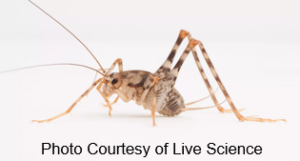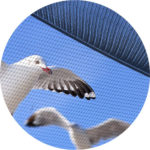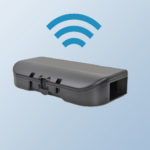The Camelback Cricket
Order: Orthoptera Family: Rhaphidophoridae Scientific Name: Ceuthophilus

The Camelback Cricket gets its’ common name from its’ humpbacked appearance, which is similar to that of a camel. They’re also commonly referred to as cave crickets or spider crickets. This species can be found in caves as well as damp and cool areas underneath damp leaves, stones, and logs. They’re commonly found in the United States as well as throughout the world.
Adults are about ½” – ¼” (12-33 mm) in length with the female ovipositor often exceeding half its’ body length. The definition of an ovipositor is an egg-laying structure. The coloring of the insect is light to dark brown and often molted with lighter or darker areas. They do lack wings and possess large hind legs as well as a lengthy set of antennae, which assist them in navigating in dimly lit and/or dark environments. Nymphs are similar to adults except they are smaller and the females do not possess an ovipositor. Eggs, which are deposited by females will hatch in the Spring. Camelback crickets go through Gradual Metamorphosis, which is three life cycle stages consisting of an egg; a nymph; and an adult.
Around commercial structures, the Camelback Cricket is commonly found in cool, damp conditions which may also include underneath mulch; railroad ties, wood piles, debris, etc. For residential structures, they can be found in wells; drainage culverts/pipes; underneath air conditioning units and their concrete support pads; in sheds; underneath decks; etc. Interior-wise, they’re commonly found in basements; utility rooms; crawl spaces; garage spaces; etc. Once indoors, they’re a nuisance pest; become problematic; and can breed throughout the year. Contingent upon areas of interior harborage, their excrement can stain textiles, belongings, etc. They mostly hide during the daytime hours and are active at night. Camelback Crickets do not chirp!
The first step for control & elimination of Camelback Crickets is proper identification. Once properly identified, Integrated Pest Management (IPM) practices begin on the exterior by reducing and/or eliminating damp harborage areas. If applicable, crawl spaces should be dry and well-ventilated. Exclusion methods can be performed to seal viable points of entry. Indoors, a vacuum cleaner can be utilized for the safe removal of these insects in lieu of pesticide applications. If applicable, be sure to dispose of the vacuum cleaner bag in the appropriate manner. Glue board monitors can also be safely used to reduce interior population levels. If pesticide application(s) need to be introduced, an approved residual insecticide can be utilized by delivering a crack and crevice application to the appropriate areas. For exterior applications, power sprayings can be performed to reduce and control population levels which will also mitigate the risk of pest entry. Approved granular bait formulations can also be deployed as needed. Remember: The Label is the Law!
Tip→ In most geographic areas, the season for Camelback Crickets is in the fall. Proactive measures implemented prior to the fall season will assist in preventing these insects from becoming problematic.
Submitted by: Joe Romito, ACE
Senior Food Safety Consultant
RK Environmental Services
Foreign Supplier Verification
 A couple years ago, Comprehensive Food Safety (CFS) was contacted by a vendor of an existing client to seek assistance to address FDA observations associated with a farm in another country. The issues were a result of an FDA on-site inspection. Additionally, the vendor did not have a Foreign Supplier Verification Program (FSVP) written for the foreign supplier in question, which is needed to import food products into the United States.
A couple years ago, Comprehensive Food Safety (CFS) was contacted by a vendor of an existing client to seek assistance to address FDA observations associated with a farm in another country. The issues were a result of an FDA on-site inspection. Additionally, the vendor did not have a Foreign Supplier Verification Program (FSVP) written for the foreign supplier in question, which is needed to import food products into the United States.
CFS worked closely with the vendor and the foreign supplier to address the on-site observations that were made by the FDA. Recommendations to address each observation were provided by the Consultant and discussed with the vendor and foreign supplier. Documentation consisting of training records, new SOPs, etc. were developed and implemented and on the farm activities that included new equipment and processes were executed. The vendor provided this information to the FDA showing that the observations made by the FDA investigator were addressed. All corrective actions provided to the FDA were accepted and this matter was closed.
Regarding a lack of an FSVP, the Consultant worked closely with the vendor and foreign supplier to develop this program and to provide the necessary supplier verification activities supporting the safety of the food that was being imported into the United States. Meetings with the FDA to review the content of the FSVP and detailed supporting supplier verification activity documentation occurred. The FDA agreed that the vendor had met all FSVP regulations and allowed the movement of the product to the United States for sale.
As a result of this initial event, the vendor and foreign supplier have become FSVP Qualified Individuals through their FSVP training with CFS. CFS continues to play a key role in the vendor’s FSVP program.
This type of service is provided by CFS and can be tailored to the needs of the client.
Take Away Tips:
- Experts can make easy work of a complicated problem.
- Consultants are valuable for their past and present experiences.
- It is important to stay up to date with regulatory changes.
Submitted by: Mark Dargey
Director, Regulatory Compliance
Comprehensive Food Safety














